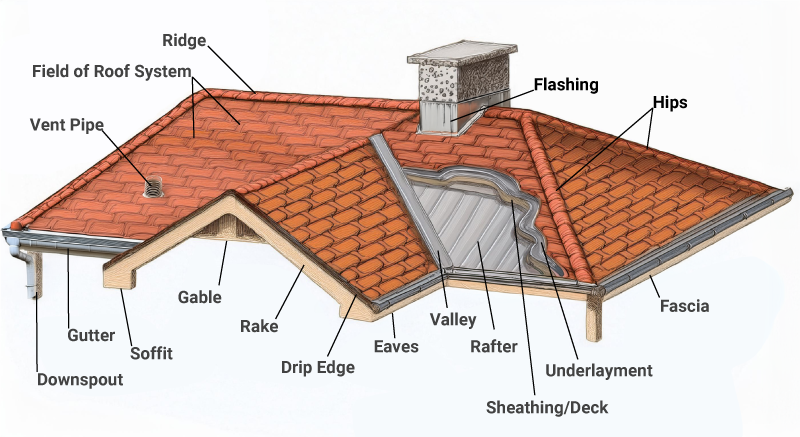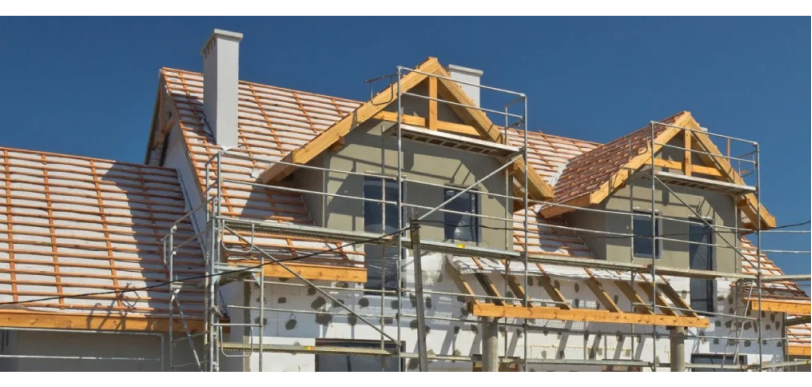Whether you're a homeowner looking to understand your roof a little better or a roofing professional aiming to stay sharp on the details, it's helpful to know the ins and outs of what makes up a roof. In this guide, we’ll break down the essential components so you can talk confidently about roofing, spot potential issues, and make informed decisions for your home or project.
1. Roof Structure: The Framework
The structure is the backbone of your roof—literally. It’s what gives your roof its shape and strength. Without it, the rest of the roofing system couldn’t do its job.
- Rafters: These diagonal wooden beams stretch from the peak (ridge) down to the eaves. They’re one of the primary supports that give the roof its slope.
- Trusses: Pre-fabricated triangular units that offer superior load-bearing capacity and are commonly used in new constructions.
- Ceiling Joists: Horizontal beams that tie opposing walls together and support the ceiling below the attic.
2. Roof Decking (Sheathing): The Base Layer
Decking, often made from plywood or OSB (oriented strand board), is the layer nailed to the trusses or rafters. It creates a solid surface for all the other layers to rest on. It’s the quiet foundation doing a lot of heavy lifting.
3. Underlayment: Moisture Barrier
Underlayment is your roof’s backup defense against the elements. Laid between the decking and the outer covering, it helps prevent moisture from seeping into your home.
- Felt Paper: An older yet still widely used material that provides basic moisture protection.
- Synthetic Underlayment: Lightweight, tear-resistant, and more water-resistant than felt—an increasingly popular modern option.
- Ice and Water Shield: A self-sealing waterproof membrane used in high-risk areas like valleys and eaves.
4. Roof Covering: First Line of Defense
The roof covering is the part you see—and what stands between your home and the weather. It plays a huge role in your roof’s performance and curb appeal.
- Shingles: Most common and cost-effective. Available in asphalt, wood, and architectural styles. See more
- Tiles: Often made from clay or concrete—heavy, long-lasting, and distinctive in appearance.
- Metal Panels: Great for energy efficiency and longevity, and increasingly popular on modern homes.
5. Flashing: Water Protection at Vulnerable Points
Roof flashing is thin, often metal material placed wherever your roof has a seam or joint—think chimneys, skylights, or valleys. Its job is to direct water away from those weak points before it can sneak in.
- Chimney & Vent Flashing: Prevents water infiltration around roof penetrations.
- Valley Flashing: Channels water where two slopes meet and sends it safely off the roof.
- Step Flashing: Used where roof meets walls or dormers, working with shingles for leak-free protection.
6. Roof Edge Components
The edges of your roof may seem like small details, but they play an essential role in keeping your structure watertight and properly ventilated.
- Eaves: The part of the roof that overhangs the wall, often housing gutters and soffits for ventilation.
- Rake: The angled edge running from the eaves up to the ridge. Read more
- Drip Edge: A narrow strip of metal that helps channel water off your roof and away from the fascia.
- Fascia & Soffit: Fascia is the vertical edge behind the gutters; soffit is the underside of the eaves—usually vented to allow air into the attic.

7. Roof Ventilation: Regulating Temperature and Moisture
A well-ventilated roof prevents excess heat and moisture from building up in the attic, which can lead to mold, warped wood, and high energy bills.
- Ridge Vents: Sit along the peak of the roof and allow hot air to escape.
- Soffit Vents: Let cooler air in at the eaves, enabling proper circulation.
- Gable Vents: Installed in the gable ends to supplement ventilation in older homes.
8. Gutters and Downspouts: Rainwater Management
Gutters catch rainwater that flows off the roof, while downspouts carry it safely away from your foundation. Explore gutter system parts
- Gutters: Installed along the eaves, they collect runoff and funnel it to downspouts.
- Downspouts: Direct water from gutters to ground level or drainage systems.
9. Ridge, Hip & Valley: Roof Geometry
The places where roof planes meet or separate—ridges, hips, and valleys—are critical for shaping your roof and handling water runoff.
- Ridge: The top horizontal line where two roof slopes meet.
- Hip: The outward-angled intersection of two roof slopes, commonly found on hip-style roofs.
- Valley: The inward-angled trough between two slopes—especially vulnerable to water, so proper flashing is a must.
Why It Matters: Roof Knowledge is Roof Power
Knowing your roof’s anatomy helps you spot issues early, speak your contractor’s language, and make smarter choices about repairs and upgrades. Plus, understanding how everything works together can help extend your roof’s lifespan.
RoofScope Makes Roof Planning Easier
At RoofScope, we provide detailed aerial roof measurement reports that capture every detail—ridges, valleys, hips, and more. Our technology is backed by expert CAD technicians, and our measurements are guaranteed to be at least 99% accurate. Whether you’re managing repairs, estimates, or a full re-roofing project, we’ve got the tools to make your job easier.
See pricing and get started today—or visit NRCA for more professional roofing standards and resources.
written by RoofScope published on 08. 12. 2024

